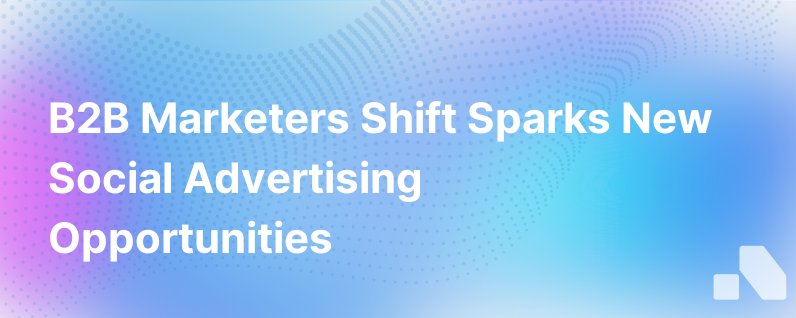
In today's digital-first marketplace, B2B marketers face a unique set of challenges when it comes to capturing the attention and earning the trust of potential clients. Social media advertising has been a cornerstone of digital marketing strategies for years, a way to reach targeted audiences through sophisticated ad platforms like LinkedIn, Facebook, and Twitter.
However, a noticeable shift is occurring in B2B marketing circles: companies are increasingly questioning the ROI of social advertising. Concerns about data privacy, ad fatigue among audiences, and uncertain economic conditions are just a few reasons why B2B marketers are reassessing their social advertising efforts. This recalibration leads to questioning whether traditional forms of social advertising remain the most effective use of limited budgets. As the tide of opinion starts to turn, a very real opportunity arises for savvy marketers to innovate and get ahead.
The Pullback from Social Advertising: Why Now?
Several factors are contributing to B2B marketers pulling back from social ad spend:
- Data Privacy Changes: With GDPR, CCPA, and upcoming privacy updates like Apple's iOS 14 changes, it’s getting harder to track and target audiences online with the same level of precision, leading to lower ad efficacies.
- Rising Costs and Diminishing Returns: As more B2B companies flock to social platforms, the cost for ads increases while the attention of users gets more and more fragmented.
- Audience Fatigue: Users are tired of being bombarded with targeted advertising, leading to banner blindness and lower engagement.
- Economic Uncertainty: Economic headwinds encourage more caution in marketing budgets, focusing investment on channels with clearly measurable returns.
The Opportunity: Innovative Tactics and Strategies
In a competitive landscape, where standing out is a constant battle, this shift away from social advertising creates a unique opening. Those who pivot effectively can capture the attention of key decision-makers in ways that competitors, sticking to the old playbook, cannot.
Content Marketing and Thought Leadership
Rather than trying to catch a buyer's eye with a fleeting ad, B2B marketers can invest more heavily in content marketing strategies. This involves creating and distributing valuable, relevant, and consistent content to attract and engage a clearly-defined audience. By doing so, marketers can establish their brand as a thought leader and trusted source of information.
Content forms like whitepapers, e-books, in-depth blog posts, and webinars can showcase a company's expertise and provide real value to potential customers. This approach helps build brand credibility and, over time, can greatly influence purchasing decisions.
Account-Based Marketing (ABM)
ABM treats each high-value account as a market of one, focusing personalized campaigns and resources on decision-makers within targeted organizations. By pulling back from broader social advertising campaigns and reallocating those resources to ABM, marketers can create hyper-focused strategies that resonate strongly with the accounts most likely to convert.
Direct B2B Channels and Partnerships
Redirecting resources away from social ads doesn't mean abandoning digital efforts altogether. There are various direct channels where B2B marketers can put their energy — such as email marketing, SEO, and customer referral programs. Establishing strategic partnerships with other businesses or industry influencers can also lead to mutually beneficial marketing opportunities, bypassing the need for traditional social ads.
Community Building
Building a community around a brand or product can be more effective and sustainable than traditional social ads. This could be through user groups, online forums, or industry partnerships where ideas and best practices are exchanged. A robust community fosters loyalty and can result in organic advocacy for your brand.
Conferences and Networking
While digital dominates much of today's marketing narratives, never underestimate the power of face-to-face interactions. In-person conferences, trade shows, and networking events can leave a lasting impression and foster real-life connections that often trump online encounters. Although these require a different kind of investment, they can lead to high-value relationships and deals.
Sales Enablement Tools
Investing in sales enablement platforms that offer account research, competitive insights, and personalized sales content can be a wise reallocation of social ad budgets. Tools like this can empower sales teams to approach prospects with highly-relevant, timely proposals that stand a better chance of closing deals than broad ad campaigns.
Creativity and Branding
A pullback from social advertising doesn't equate to less creativity. On the contrary, it can spur innovative approaches to branding. Interactive content, immersive experiences such as virtual or augmented reality, and user-generated content campaigns can make your brand stand out.
Leveraging Data for Personalization
Deploying tools that harness the power of AI for data analysis can personalize experiences at scale, making engagement with your brand more meaningful. Instead of casting a wide net with ads, using data-smart tools allows for crafting individualized messages and solutions for prospects.
Conclusion
While social media advertising has traditionally held a valuable place in the B2B marketer's toolkit, the evolving digital landscape presents new challenges—and opportunities. A strategic retreat from traditional social ads can liberate marketing budgets, encourage creative thinking, and lead to more targeted, effective tactics with a clearer ROI. The key for B2B marketers is to not view the pullback as a loss but as an opportunity to innovate and stand out in a crowded digital ecosystem.
By re-centring efforts around content marketing, ABM, direct channels, community building, live networking, sales enablement, creative branding, and data-driven personalization, B2B marketers can reach their audience with greater precision, build deeper relationships, and drive more meaningful results than ever before.